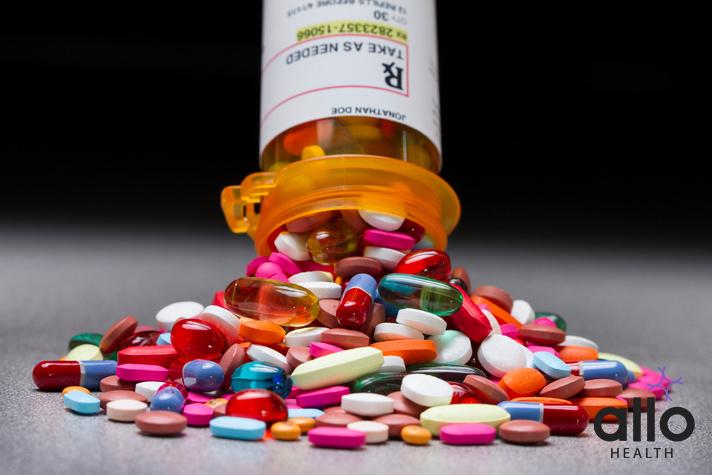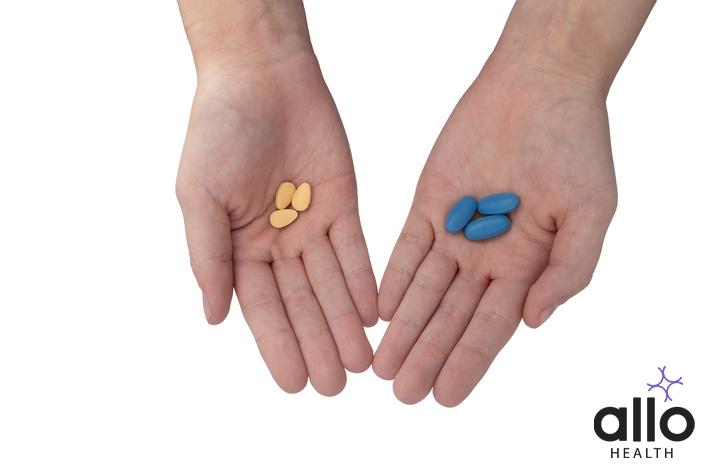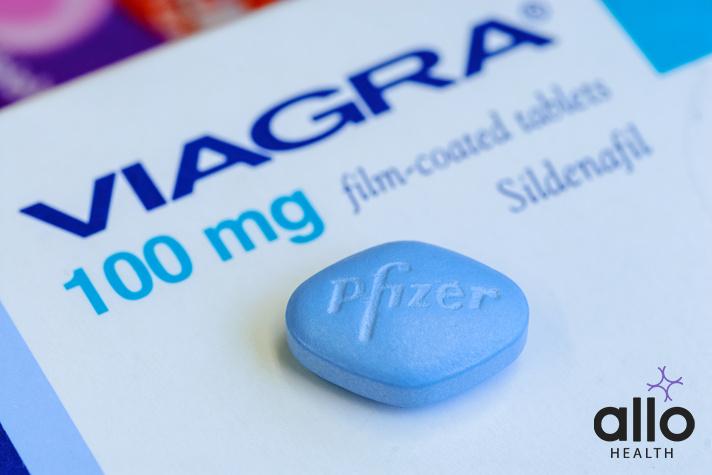Understanding Your Options: Sildenafil, Tadalafil, Vardenafil, Avanafil for Erectile Dysfunction

Allo Health is dedicated to personalized well-being, offering support and trusted information tailored to individual health goals. The platform emphasizes human-generated content, led by a distinguished medical team of experts, including physicians and sexual health specialists. Their commitment to credibility involves rigorous fact-checking, authoritative research, and continuous updates to ensure accurate, up-to-date information. Allo Health's unique approach goes beyond conventional platforms, providing expert-led insights and a continuous commitment to excellence, with user feedback playing a crucial role in shaping the platform's authoritative voice.

Dr. Aditi completed her undergraduate medical education at AJIMS, Mangalore, after which she worked in multi-speciality hospitals with COVID patients and in the Pain and Palliative medicine department. Driven by her experiences, she developed a keen interest in psychiatry. Dr. Aditi believes that mental health is just as, if not more important, than physical health.
Why This Was Upated?
Our experts continually monitor the health and wellness space, and we update our articles when new information became available.
Updated on 12 April, 2024
- Article was updated as part of our commitment to diversity, equity, and inclusion.

"The following blog article may discuss medical treatments and interventions. However, it is important to note that the information provided is for general educational purposes only and should not be considered as a substitute for professional medical advice, diagnosis, or treatment. Always seek the guidance of a qualified healthcare professional for personalized medical advice.
Book consultation
Medical treatments are complex and should be tailored to individual circumstances. The information presented in this blog may not be applicable to everyone, as each person's medical condition, history, and needs are unique. Only a qualified healthcare professional can evaluate your specific medical situation, consider relevant factors, and provide appropriate recommendations for diagnosis, treatment options, and monitoring.
It is crucial to note that self-diagnosis, self-medication, or relying solely on the information provided in this blog for treatment decisions can have serious health consequences. "
Erectile Dysfunction (ED) is a common condition that affects millions of men worldwide. While it can be a sensitive topic, advancements in medical science have made it more manageable than ever before. Among the most effective treatments are oral medications such as sildenafil, tadalafil, vardenafil, and avanafil. This article explores these options to help you understand which might be the best choice for your needs.
Sildenafil: The First Line of Defense
Sildenafil, widely known by its brand name Viagra, was the first FDA-approved medication for the treatment of ED. It works by increasing blood flow to the penis, helping to achieve and maintain an erection. Sildenafil is best taken on an empty stomach about one hour before sexual activity, and its effects can last for up to four hours.
Tadalafil: The Weekend Pill
Tadalafil, or Cialis, is known for its long-lasting effects, which can last up to 36 hours. This feature has earned it the nickname “The Weekend Pill.” Tadalafil offers more spontaneity since it doesn’t require timing the medication as closely as sildenafil. It can be taken with or without food, making it a convenient option for many.
Vardenafil: A Versatile Choice
Vardenafil, available as Levitra and Staxyn, is another popular option for treating ED. It works similarly to sildenafil but is noted for its slightly faster onset of action, often working within 25 minutes. Additionally, a lower dose of vardenafil may be required to achieve the same results as higher doses of sildenafil or tadalafil, potentially reducing side effects.
Avanafil: The Newest Option
Avanafil, sold under the brand name Stendra, is the newest ED medication on the market. It has the advantage of an even faster onset of action, with some men experiencing results in as little as 15 minutes. Avanafil is also known for having fewer side effects compared to its predecessors, making it a preferred choice for some individuals.
Choosing the Right ED Medication: Viagra, Cialis, Levitra, or Stendra
Determining which medication among Viagra (sildenafil), Cialis (tadalafil), Levitra (vardenafil), and Stendra (avanafil) is “better” depends on various factors, including individual health, treatment goals, side effects, and lifestyle considerations. Each drug has its unique properties and advantages, making them suitable for different needs. Here’s a comparative overview to help understand which might be better in specific situations:
Viagra (Sildenafil)
- Onset: About 30-60 minutes
- Duration: Up to 4-6 hours
- Best for: Men who plan their sexual activity and don’t require a long window of effectiveness.
Cialis (Tadalafil)
- Onset: About 30 minutes to 2 hours
- Duration: Up to 36 hours
- Best for: Men seeking more spontaneity over a longer period, also suitable for those with BPH.
Levitra (Vardenafil)
- Onset: About 25-60 minutes
- Duration: Up to 4-5 hours
- Best for: Men looking for a similar option to Viagra with potentially fewer side effects.
Stendra (Avanafil)
- Onset: As fast as 15 minutes
- Duration: Up to 6 hours
- Best for: Men seeking the quickest onset of action with a moderate duration of effectiveness.
There isn’t a one-size-fits-all answer to which ED medication is better. The “best” option is highly individual:
- For Planned Intimacy: Viagra or Levitra might be preferred due to their shorter duration.
- For Spontaneity: Cialis, with its long-lasting effects, could be the best choice.
- For Quick Onset: Stendra might be ideal for those prioritizing rapid effectiveness.

Cialis vs. Viagra: Understanding the Differences
Cialis (tadalafil) and Viagra (sildenafil) are both popular medications for the treatment of erectile dysfunction (ED), but they have some key differences that might make one more suitable for you than the other. Understanding these differences can help you and your healthcare provider make the best choice for your needs and lifestyle.
Active Ingredient and Function
- Cialis: Contains tadalafil, which is effective for treating both ED and benign prostatic hyperplasia (BPH).
- Viagra: Contains sildenafil and is solely used for treating ED.
Duration of Effect
- Cialis: Known for its long duration of action, Cialis can last up to 36 hours. This extended period allows for more spontaneity.
- Viagra: Effects last for up to 4-6 hours, requiring more planning for sexual activity.
Daily Use Option
- Cialis: Offers a unique advantage with a low-dose (2.5 mg or 5 mg) option, making it suitable for daily use. This ensures constant readiness without the need to plan for sexual activity.
- Viagra: Typically used on an as-needed basis and doesn’t offer a daily dosing option.
Onset of Action
- Both medications can be taken about 30 minutes before sexual activity, though some individuals may experience variations in this timeframe. Cialis might offer a slightly faster onset of action for some users.
Effectiveness for BPH
- Cialis: Apart from treating ED, Cialis is also FDA-approved to treat the symptoms of BPH, making it a dual-purpose medication.
- Viagra: Does not have approval for treating BPH and is used exclusively for ED.
Side Effects
Both medications can cause similar side effects, such as headaches, flushing, nasal congestion, upset stomach, back pain, and muscle aches. However, the side effect profile for each individual can vary, and some may tolerate one medication better than the other.
Interaction with Food
- Cialis: Can be taken with or without food, without any significant impact on its absorption or effectiveness.
- Viagra: It’s recommended to take Viagra on an empty stomach for the best results, as a high-fat meal can delay its absorption and effectiveness.
Levitra vs. Viagra: Comparing ED Treatment Options
Levitra (vardenafil) and Viagra (sildenafil) are both effective treatments for erectile dysfunction (ED), belonging to the same class of medications known as phosphodiesterase type 5 (PDE5) inhibitors. Despite their similarities in function, there are distinct differences between the two drugs in terms of timing, side effects, and other characteristics that may influence a person’s choice or a healthcare provider’s recommendation. Here’s a breakdown of the key differences between Levitra and Viagra.
Onset of Action
- Viagra: Can take 30 to 60 minutes to start working in the body. It’s recommended to take Viagra on an empty stomach to enhance effectiveness.
- Levitra: Generally takes about 60 minutes to work, similar to Viagra, but there are instances where some users may experience quicker onset times.
Duration of Effect
- Both Levitra and Viagra: The effects of both drugs last for approximately 4 hours, meaning that they provide a sufficient window of time for sexual activity. Users are advised to take the medication in anticipation of sexual activity within this timeframe.
Side Effects
While both medications can cause similar side effects due to their pharmacological similarities, there are notable differences in the prevalence of certain side effects:
- Viagra: Common side effects include headaches, flushing, upset stomach, nasal congestion, urinary tract infections, vision changes (such as increased sensitivity to light, blurred vision, or a blue tint to vision), diarrhea, and dizziness. Rarely, it may cause a rash or muscle aches.
- Levitra: Tends to have fewer common side effects than Viagra. Notably, it is less likely to be associated with muscle aches and rash. However, similar to Viagra, it can cause vision changes, including color vision changes where blue and green colors might be distorted.
Efficacy
- Both Levitra and Viagra are highly effective for treating ED, with slight variations in efficacy reported in different studies. Personal response to each medication can vary, making it important for individuals to try both (at different times) to determine which works best for them.
Stendra vs. Viagra: A Comparison of ED Medications
Stendra (avanafil) and Viagra (sildenafil) are both prescribed for the treatment of erectile dysfunction (ED), but they differ in several key areas, including the onset of action, side effects, and the availability of generic versions. These differences can make one medication more suitable than the other for certain individuals, depending on their health, lifestyle, and treatment preferences.
Market Introduction and Availability
- Viagra: Introduced in 1998, Viagra is the first ED medication to hit the market, making it the most well-known. Generic versions of sildenafil (the active ingredient in Viagra) are widely available, offering a more cost-effective option.
- Stendra: As the newest ED drug, introduced in 2012, Stendra does not yet have a generic version available, which may affect its cost and accessibility for some patients.
Onset of Action
- Viagra: Requires 30 to 60 minutes to become effective, with the recommendation to take it on an empty stomach for the best results.
- Stendra: Known for its fast-acting nature, Stendra can be effective as soon as 15 minutes after taking a 100-mg or 200-mg dose, offering a quicker onset compared to Viagra.
Duration of Effect
- Viagra: The effects of Viagra last about 4 to 6 hours, providing a significant window for sexual activity.
- Stendra: Similar to Viagra, Stendra’s effects can last up to 6 hours, though individual experiences may vary.
Side Effects
The side effect profiles of Stendra and Viagra also show some differences, primarily in terms of severity and types of common side effects:
- Viagra: Common side effects include headaches, flushing, upset stomach, nasal congestion, urinary tract infections, vision changes, diarrhea, dizziness, and in some cases, muscle aches and nausea.
- Stendra: Tends to have milder side effects in comparison. The most common side effect unique to Stendra is a sore throat, while it less frequently causes vision changes, nausea, and muscle aches that are more commonly associated with Viagra.
Efficacy and Patient Preference
Both Stendra and Viagra are effective for treating ED. The choice between them may come down to how quickly an individual wants the medication to work and their sensitivity to side effects. Stendra’s rapid onset makes it appealing for those seeking more spontaneity, while its milder side effect profile may be preferable for those who are sensitive to the side effects of other PDE5 inhibitors.

Levitra vs. Cialis: Comparing ED Treatment Options
Levitra (vardenafil) and Cialis (tadalafil) are both effective treatments for erectile dysfunction (ED), but they have distinct characteristics that cater to different needs and preferences. Understanding the differences between Levitra and Cialis can help individuals and their healthcare providers decide which medication is more suitable for their specific situation.
Purpose and Use
- Cialis: Beyond treating ED, Cialis is approved for the treatment of benign prostatic hyperplasia (BPH), also known as an enlarged prostate. It can be taken as a daily medication, offering a continuous solution that benefits sexual function and alleviates symptoms of BPH.
- Levitra: Primarily focuses on treating ED and does not have approval for BPH treatment. It is intended for use on an as-needed basis, before sexual activity.
Onset of Action
- Cialis: This can be effective as soon as 30 minutes after taking the pill, making it a quick option for those planning sexual activity. Its flexibility also allows for daily use in a lower dosage, which means continuous readiness without the need to time the medication as closely.
- Levitra: Requires at least 1 hour before it becomes effective, necessitating a bit more planning for sexual encounters.
Duration of Effect
- Cialis: Notably long-lasting, Cialis stays in the body for up to 36 hours, which is significantly longer than Levitra. This extended duration offers a considerable window for sexual activity and is why it’s often dubbed “The Weekend Pill.”
- Levitra: The effects last for about 4 to 5 hours, which is comparable to Viagra but shorter than Cialis.
Side Effects
While both medications share common side effects associated with PDE5 inhibitors, such as headaches, flushing, and nasal congestion, there are some differences:
- Cialis: Unique side effects may include muscle aches and pains in the limbs, which are not commonly associated with Levitra.
- Levitra: Generally, it shares the common PDE-5 inhibitor side effects but does not commonly cause muscle aches and limb pain associated with Cialis.

Understanding How ED Medications Work
Erectile Dysfunction (ED) medications, specifically phosphodiesterase type 5 (PDE5) inhibitors, are a cornerstone in the treatment of ED. They function by targeting a specific enzyme in the body to enhance erectile response. Here’s a brief overview of how these medications work and some general guidance on their use:
Mechanism of Action
- Relaxation of Penile Muscles: PDE5 inhibitors work by relaxing the smooth muscles in the blood vessels of the penis, thereby enhancing blood flow.
- Enhanced Blood Flow: With sexual stimulation, increased blood flow to the penis leads to an erection by filling the penile corpora cavernosa, the two chambers in the penis that swell with blood to produce an erection.
- Inhibition of PDE5: These medications specifically inhibit the PDE5 enzyme, which is found in penile tissues. By inhibiting this enzyme, PDE5 inhibitors prevent the breakdown of cyclic guanosine monophosphate (cGMP), a molecule that helps induce muscle relaxation and blood vessel dilation.
Health Conditions and Medications That May Interfere with ED Medications
- Nitrate Medicines: Commonly prescribed for chest pain (angina), such as nitroglycerin, isosorbide mononitrate, and isosorbide dinitrate. The combination with ED medications can lead to a dangerous drop in blood pressure.
- Alpha-blockers: Used for conditions like an enlarged prostate or male pattern baldness (e.g., dutasteride, finasteride). These can also cause blood pressure to drop significantly when used with ED drugs.
- CYP3A4 Inhibitors: Medications like itraconazole, ketoconazole, and ritonavir can increase the levels of ED medications in the blood, potentially leading to toxicity or increased side effects.
Medical Conditions That May Preclude the Use of ED Medications
- Blood Pressure Issues: Both very low blood pressure (hypotension) and uncontrolled high blood pressure (hypertension) can make ED medications unsafe.
- Severe Liver Disease: This can affect the body’s ability to metabolize ED medications, leading to increased side effects.
- Kidney Disease Requiring Dialysis: Affects medication clearance from the body.
- Recent Heart or Blood Vessel Problems: Such as a recent heart attack, stroke, or serious heart rhythm disorder.
- Inherited Eye Diseases: Particularly those affecting the retina, could be worsened by ED medications.
Common Side Effects of Oral ED Medications
- Flushing, headaches, upset stomach, visual changes (e.g., a blue tinge, sensitivity to light, blurred vision), stuffy or runny nose, back pain, and dizziness are among the most commonly reported side effects.
Serious Side Effects to Be Aware Of:
- Hearing or Vision Loss: There have been instances of sudden hearing or vision loss associated with ED medications, though it’s unclear if the medication is the direct cause.
- Priapism: A prolonged erection lasting more than four hours (priapism) is a medical emergency requiring immediate attention to prevent permanent damage.
Important Considerations
- Doctor’s Prescription: All ED medications should be used under the guidance of a healthcare provider.
- Adjustments for Health Conditions: Doses may need to be adjusted for individuals with certain health conditions or those taking other medications that might interact with ED medications.
- Timing and Effectiveness: While these medications act relatively quickly, the precise onset of action can vary. Sexual stimulation is required to achieve an erection, even after taking ED medication.
Most Asked Questions
-
How do I choose the right ED medication?
Consider onset time, duration, side effects, and any health conditions or medications. Consult a healthcare provider for personalized advice.
-
Can I take ED medication with other medicines?
Be cautious with nitrates, alpha-blockers, and CYP3A4 inhibitors. Always inform your doctor about all medications you're taking.
-
What are common side effects?
Common side effects include headaches, flushing, nasal congestion, and upset stomach. Serious side effects require immediate medical attention.
-
Are ED medications safe for heart problems?
Patients with recent heart issues or uncontrolled blood pressure should consult their doctor due to potential risks.
-
When should I take ED medications before sexual activity?
Sildenafil and Vardenafil: 30-60 minutes before; Tadalafil: 30 minutes to 36 hours before; Avanafil: 15 minutes before. Sexual stimulation is necessary for these medications to work.








































